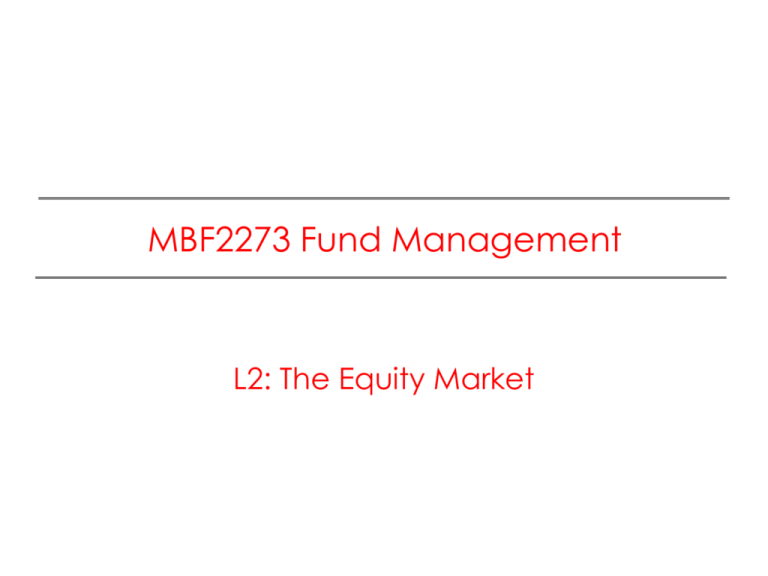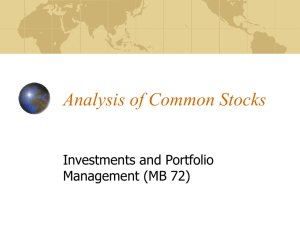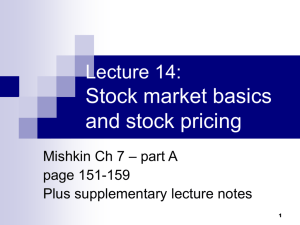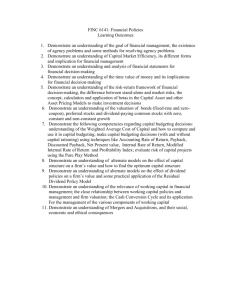Bachelor of Business Administration (Hons) MFC
advertisement

MBF2273 Fund Management L2: The Equity Market Google IPO In August of 2004, Google went public, auctioning its shares in an unusual IPO format. The shares originally sold for $85 / share, and closed at over $100 on the first day. In November of 2010, shares are trading on Nasdaq at over $620 / share. Facebook IPO Facebook held its IPO on May 18, 2012. The IPO was one of the biggest in technology, and the biggest in Internet history, with a peak market capitalization of over $104 billion. Offer price was $38/share. It closed at $38.23/share. The IPO raised $16 billion, making it the third largest in U.S. history (just ahead of AT&T Wireless and behind only General Motors and Visa Inc.). The stock price left the company with a higher market capitalization than all but a few U.S. corporations – surpassing heavyweights such as Amazon.com, McDonald's, Disney, and Kraft Foods – and made Zuckerberg's stock worth $19 billion. Trends in Global Equity and Bond Markets, 2001 - 2009 World Equity and Stock Markets (Trillions of USD) 100 90 80 70 60 Stock Market 50 Debt Market 40 30 20 10 0 2001 2002 2003 2004 2005 2006 2007 2008 2009 4 Investing in Stocks 1. Represents ownership in a firm 2. Earn a return in two ways – Price of the stock rises over time – Dividends are paid to the stockholder 3. Stockholders have claim on all assets 4. Right to vote for directors and on certain issues 5. Two types ─ Common stock • Right to vote • Receive dividends ─ Preferred stock • Receive a fixed dividend • Do not usually vote Investing in Stocks: How Stocks are Sold • Organized exchanges – NYSE is best known, with daily volume around 4 billion shares, with peaks at 7 billion. – “Organized” used to imply a specific trading location. But computer systems (ECNs) have replaced this idea. – Others include the ASE (US), and Nikkei, LSE, DAX (international) – Listing requirements exclude small firms Investing in Stocks: How Stocks are Sold • Over-the-counter markets – Best example is NASDAQ – Dealers stand ready to make a market – Today, about 3,000 different securities are listed on NASDAQ. – Important market for thinly-traded securities— securities that don’t trade very often. Without a dealer ready to make a market, the equity would be difficult to trade. Investing in Stocks: Organized vs. OTC • Organized exchanges (e.g., NYSE) – Auction markets with floor specialists – 25% of trades are filled directly by specialist – Remaining trades are filled through SuperDOT • Over-the-counter markets (e.g., NASDAQ) – Multiple market makers set bid and ask prices – Multiple dealers for any given security Investing in Stocks: ETFs Exchange Traded Funds are a recent innovation to help keep transaction costs down while offering diversification. Represent a basket of securities Traded on a major exchange Index to a specific portfolio (eg., the S&P 500), so management fees are low (although commissions still apply) Exact content of basket is known, so valuation is certain Computing the Price of Common Stock • Valuing common stock is, in theory, no different from valuing debt securities: determine the future cash flows and discount them to the present at an appropriate discount rate. • We will review four different methods for valuing stock, each with its advantages and drawbacks. Computing the Price of Common Stock: The One-Period Valuation Model • Simplest model, just taking using the expected dividend and price over the next year. • Computing the Price of Common Stock: The One-Period Valuation Model What is the price for a stock with an expected dividend and price next year of $0.16 and $60, respectively? Use a 12% discount rate Answer: Computing the Price of Common Stock: The Generalized Dividend Valuation Model • Most general model, but the infinite sum may not converge. • • Rather than worry about computational problems, we use a simpler version, known as the Gordon growth model. Computing the Price of Common Stock: The Gordon Growth Model • Same as the previous model, but it assumes that dividend grow at a constant rate, g. That is, Computing the Price of Common Stock: The Gordon Growth Model The model is useful, with the following assumptions: Dividends do, indeed, grow at a constant rate forever The growth rate of dividends, g, is less than the required return on the equity, ke. Computing the Price of Common Stock: The Generalized Dividend Valuation Model • The price earnings ratio (PE) is a widely watched measure of much the market is willing to pay for $1.00 of earnings from the firms. • Computing the Price of Common Stock: The Price Earnings Valuation Method If the industry PE ratio for a firm is 16, what is the current stock price for a firm with earnings for $1.13 / share? Answer: Price = 16 $1.13 = $18.08 How the Market Sets Security Prices • Generally speaking, prices are set in competitive markets as the price set by the buyer willing to pay the most for an item. • The buyer willing to pay the most for an asset is usually the buyer who can make the best use of the asset. • Superior information can play an important role. How the Market Sets Security Prices • Consider the following three valuations for a stock with certain dividends but different perceived risk: • Bud, who perceives the lowest risk, is willing to pay the most and will determine the “market” price. Errors in Valuation Although the pricing models are useful, market participants frequently encounter problems in using them. Any of these can have a significant impact on price in the Gordon model. Problems with Estimating Growth Problems with Estimating Risk Problems with Forecasting Dividends Errors in Valuation To illustrate this point, the next two slides show how dramatically a stock’s price can change by simple changes in the expected dividend growth rate (Table 13.1) and required return (Table 13.2). Errors in Valuation: Dividend growth rates Errors in Valuation: Required returns Errors in Valuation These two slides also point out that security valuation is not an exact science. Considering different growth rates, required rates, etc., is important in determining if a stock is a good value as an investment. Case: The 2007–2009 Financial Crisis and the Stock Market • The financial crisis, which started in August 2007, was the start of one of the worst bear markets. • The crisis lowered “g” in the Gordon Growth model—driving down prices. • Also impacts ke—higher uncertainty increases this value, again lowering prices. • The expectations were still optimistic at the start of the crisis. But, as the reality of the severity of the crisis was understood, prices plummeted. Buying Foreign Stocks • Buying foreign stocks is useful from a diversification perspective. However, the purchase may be complicated if the shares are not traded in the U.S. • American depository receipts (ADRs) allow foreign firms to trade on U.S. exchanges, facilitating their purchase. U.S. banks buy foreign shares and issue receipts against the shares in U.S. markets. Regulation of the Stock Market • The primary mission of the SEC is “…to protect investors and maintain the integrity of the securities markets.” • The SEC brings around 500 actions against individuals and firms each year toward this effort. This is accomplished through the joint efforts of four divisions. Regulation of the Stock Market: Divisions of the SEC • Division of Corporate Finance: responsible for collecting, reviewing, and making available all of the documents corporations and individuals are required to file • Division of Market Regulation: establishes and maintains rules for orderly and efficient markets. Regulation of the Stock Market: Divisions of the SEC • Division of Investment Management: oversees and regulates the investment management industry • Division of Enforcement: investigates violations of the rules and regulations established by the other divisions. Global Equity Market: Recent Trends (1) Stock exchanges becoming public traded organizations Historically stock markets were private organizations. However, in February of 2001 Germany’s stock exchange, the Deutsche Stock Exchange went public; In July of 2001, both the London Stock Exchange and Euronext went public; In 2006, the NYSE went public. • Implications of publically traded exchanges: Inclusion in investor portfolios. Possibility of take-overs 30 Global Equity Market: Recent Trends (2) Consolidations (mergers and acquisitions) among independent stock exchanges. On September 22, 2000, Euronext Stock Exchange was formed through the merger of the national stock exchanges of France, Belgium, and the Netherlands. In December 2001, Euronext acquired the shares of the London International Financial Futures and Options Exchange (LIFFE), in 2002 it acquired the Portuguese Stock Exchange. On April 4, 2007, the New York Stock Exchange and Euronext merged to form NYSE Euronext. In February 2011, NYSE Euronext and Deutsche Börse announce that they were engaged in "advanced merger talks.” On April 1st, NASDAQ countered with a higher bid for NYSE Euronext (19% over Deutsche’s offer); however, the offer is rejected by NYSE Euronext as not “strategically attractive.” 31 Global Equity Market: Recent Trends • In 2006 and 2007 NASDAQ twice attempted a hostile takeover of the London Stock Exchange. Both takeover attempts were rejected by LSE shareholders. • In late 2010, Singapore offered to buy out the Australian Securities Exchange for $7.8 billion The offer was recently rejected by the Australian Government. • In February 2011, the London Stock Exchange announced a merger with the Toronto Stock Exchange. • Why are exchanges merging? (1) cost reductions (to the exchanges themselves through economies of scale). (2) to expand global capital raising benefits (IPOs) to corporations and (3) to provide liquidity (turnover) and global outreach benefits to investors. 32 Global Equity Market: Recent Trends (3) Increasing number of national stock markets around the world. John Thain, 2006, CEO, NYSE: “Most countries have an army, a flag, an airline, and a [stock] exchange.” Today there are approximately 300 stock exchanges. Many emerging countries have their own stock markets. • Part of their privatization process. 33 Gordon Growth Model • The Gordon Growth Model, also known as the dividend discount model (DDM), is a method for calculating the intrinsic value of a stock, exclusive of current market conditions. • The model equates this value to the present value of a stock's future dividends. • There are two basic forms of the model: the stable model and the multistage growth model. 34 Gordon Growth Model • Stable Model • Value of stock = D1/ (k - g) where: D1 = next year's expected annual dividend per share k = the investor's discount rate or required rate of return, which can be estimated using the Capital AssetPricing Model or the Dividend Growth Model (see Cost of Equity) g = the expected dividend growth rate (note that this is assumed to be constant) 35 Gordon Growth Model • Multistage Growth Model • When dividends are not expected to grow at a constant rate, the investor must evaluate each year's dividends separately, incorporating each year's expected dividend growth rate. • However, the multistage growth model does assume that dividend growth eventually becomes constant. • See the example in the next slides. 36 Gordon Growth Model • Stable Model Let's assume XYZ Company intends to pay a $1 dividend per share next year and you expect this to increase by 5% per year thereafter. • Let's further assume your required rate of return on XYZ Company stock is 10%. Currently, XYZ shares are trading at $10 per share. • Using the formula e, we can calculate that the intrinsic value of one share of XYZ Company stock is: • $1.00/(.10-.05) = $20 • According to the model, XYZ Company stock is worth $20 per share but is trading at $10; the Gordon Growth Model suggests the stock is undervalued. • The stable model assumes that dividends grow at a constant rate. This is not always a realistic assumption for growing (or declining) companies, which gives way to the multistage growth model. 37 Gordon Growth Model • Multistage Growth Model Let's assume that during the next few years XYZ Company's dividends will increase rapidly and then grow at a stable rate. • Next year's dividend is still expected to be $1 per share, but dividends will increase annually by 7%, then 10%, then 12%, and then steadily increase by 5% after that. • By using elements of the stable model, but analyzing each year of unusual dividend growth separately, we can calculate the current fair value of XYZ Company stock. • Here are the inputs: D1 = $1.00 k = 10% g1 (dividend growth rate, year 1) = 7% g2 (dividend growth rate, year 2) = 10% g3 (dividend growth rate, year 3) = 12% gn (dividend growth rate thereafter) = 5% 38 Gordon Growth Model • Since we have estimated the dividend growth rate, we can calculate the actual dividends for those years: D1 = $1.00 D2 = $1.00 * 1.07 = $1.07 D3 = $1.07 * 1.10 = $1.18 D4 = $1.18 * 1.12 = $1.32 39 Gordon Growth Model • We then calculate the present value of each dividend during the unusual growth period: $1.00 / (1.10) = $0.91 $1.07 / (1.10)2 = $0.88 $1.18 / (1.10)3 = $0.89 $1.32 / (1.10)4 = $0.90 40 Gordon Growth Model • Then, we value the dividends occurring in the stable growth period, starting by calculating the fifth year's dividend: D5 = $1.32*(1.05) = $1.39 • We then apply the stable-growth GGM formula to these dividends to determine their value in the fifth year: $1.39 / (0.10-0.05) = $27.80 • The present value of these stable growth period dividends are then calculated: $27.80 / (1.10)5 = $17.26 41 Gordon Growth Model • Finally, we can add the present values of XYZ's future dividends to arrive at the current intrinsic of XYZ stock: $0.91+$0.88+$0.89+$0.90+$17.26 = $20.84 • The multistage growth model also indicates that XYZ stock is undervalued (a $20.84 intrinsic value, compared with a $10 trading price). • Analysts frequently incorporate an assumed sale price and sale date into these calculations if they know the stock is not going to be held indefinitely. Also, coupon payments can be used in place of dividends when analyzing bonds. 42 Gordon Growth Model • The GGM allows investors to calculate the value of a share of stock exclusive of current market conditions. • This exclusion allows investors to make apples-to-apples comparisons among companies in different industries, and for this reason GGM is one of the most widely used equity analysis and valuation tools. • However, there is some sentiment that Gordon Growth Model’s exclusion of nondividend factors tends to undervalue stocks in companies with exceptional brand names, customer loyalty, unique intellectual property, or other nondividend, valueenhancing characteristics. 43 Gordon Growth Model • Mathematically, two circumstances are required to make the GGM effective. • First, a company must distribute dividends however, analysts frequently apply the GGM to stocks that do not pay dividends by making assumptions about what the dividend would be if the company did pay dividends). • Second, the dividend growth rate (g) cannot exceed the investor's required rate of return (k). – If g is greater than k, the result would be negative, and stocks cannot have negative values. 44 Gordon Growth Model • The GGM, especially the multistage growth model, often requires users to make somewhat unrealistic and difficult estimates of dividend growth rates (g). • It is important to understand that the GGM is highly sensitive to changes in g and k, and many analysts perform sensitivity analyses to evaluate how different assumptions change the valuation. • Under the GGM, a stock becomes more valuable when its dividend increases, the investor's required rate of return decreases, or the expected dividend growth rate increases. The GGM also implies that a stock price grows at the same rate as dividends. 45








